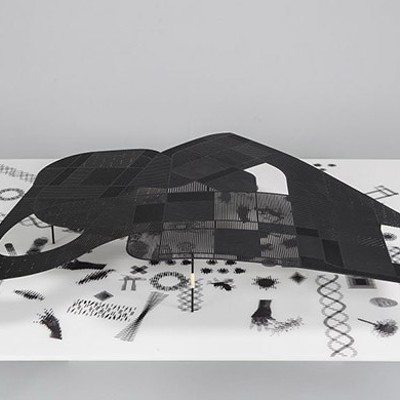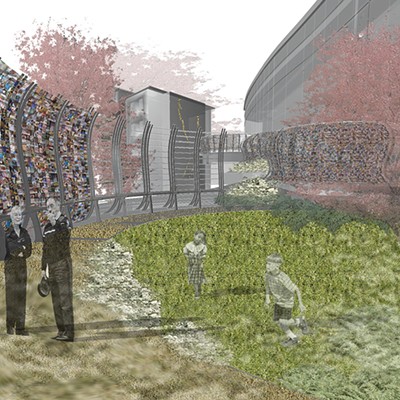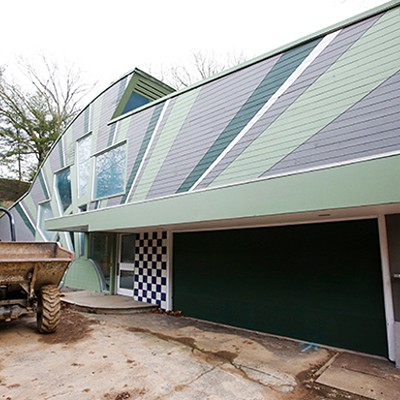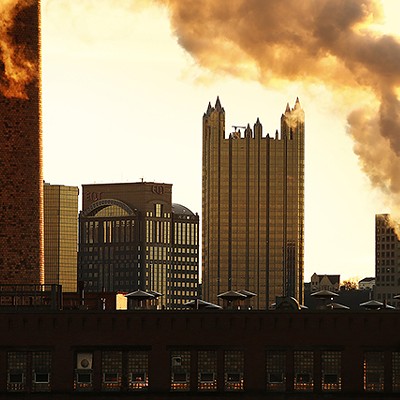I'm a big devotee of Frank Lloyd Wright, but not so much that I've ever imagined seeing him, Elvis-like, skulking around the 7-Eleven, trying to elude National Enquirer photographers. Imagining such a sighting is sort of ridiculous, but maybe not entirely baseless: Unlike the many architects who simply wish for such adulation, Wright actually was the subject of nearly fanatical devotion during his life. His Taliesin Fellowship, with camps in Wisconsin and Arizona, produced some of the world's most remarkable architecture between 1932 and 1959, when Wright died. But the organization also operated, or so many critics asserted, as a cult to the old man.
Frank Lloyd Wright's Foundation, School of Architecture and professional architecture practice still persist today as comparatively professional institutions perpetuating his artistic legacy. A new play, though, explores Wright's personal side: his curiously tabloid-like life and our continuing interest in him.
Work Song is a three-act piece that originated at the Milwaukee Repertory Theater three years ago and is now showing at Pittsburgh's City Theatre through Dec. 19. It chronicles Wright's early professional life through 1914, his mid-career crisis and resurgence in the 1930s, and an imagined episode from his last days in 1959.
Wright's life has been the subject of dramatic productions before -- a previous play and an opera -- because the actual events were such dramatic productions themselves. When Chicago's fastest-rising architectural talent absconded to Europe in 1906 with Mamah Cheney, a client's wife, the story made headlines. When Cheney and several others were murdered at Wright's Wisconsin home (in Wright's absence) by a servant gone mad in 1914, the press had an even greater field day. In 1932 Wright and a new wife, 30 years his junior, asked students to pay for the privilege of operating their farm during a 1930s drought of architectural commissions. There he goes again, said many journalists with mixed amusement and contempt, along with a certainty that they would sell more papers.
Which is what makes the play fascinating as both a drama and a cultural phenomenon. As portrayed in Act II during the 1930s Wright and the Taliesin Fellowship had numerous loyal young apprentices, as well as a steady stream of campy, eccentric guests: All he lacked were paying commissions. As a result, Wright had to elude bill collectors while raising money unscrupulously, yet hilariously. Without an immediate and necessary influx of cash, he would lose Taliesin, his home and studio, and the stage for this unfolding drama.
There is a palpable feeling of life imitating art imitating life here: Both on stage and in real life, Taliesin itself is at risk. The play, not incidentally, is paired with a fund-raising campaign to help restore Taliesin, led by Pittsburgh architect Jerry Morosco, a Taliesin graduate from the 1980s, a talented architect and continuing exponent of Wright's work.
These days, drainage and erosion problems rather than Wright's personal financial profligacy have endangered Taliesin. Still, there's something fascinating about the idea that, in times of financial need, the most effective spokesman is not simply the architecture, which is generally regarded as one of this country's great contributions to the world, but also the old man himself, complete with quips, tantrums and oracular utterances.
It's certainly an appropriate pitch for an age of celebrity. But the play doesn't quite say what its program notes do: For all its renovations and ongoing maintenance needs, Taliesin is also a great masterpiece of architecture -- not simply the backdrop for a remarkable character.
Wright himself knew his behavior was frequently bad, but excused it by pointing to his architecture. Work Song, by contrast, is weakened by the way Act III uses architecture simply as a set. Though the events are supposed to take place in the Edwin and Mamah Cheney House in Oak Park. Ill., the set actually depicts the Susan Lawrence Dana House of Springfield, Ill. Most people will probably ignore this architectural discrepancy, but it undermines the location-specific nature of the plot, to say nothing of the idea that great architecture responds to the needs of its clients.
Wright still makes good copy for the tabloids, and just like old times, the old man still needs an audience -- and our money. But even he knew that, while a rich character might make headlines, great architecture is a more substantive art.


















